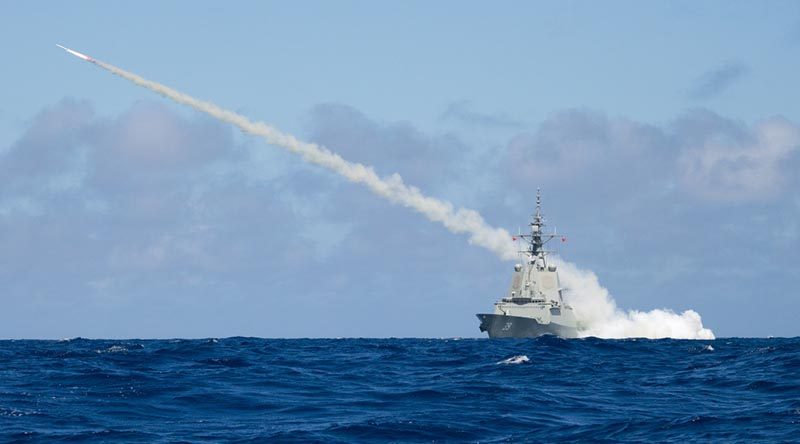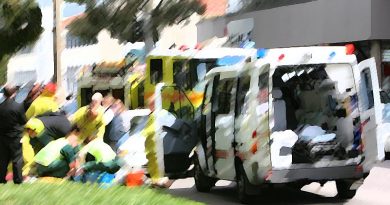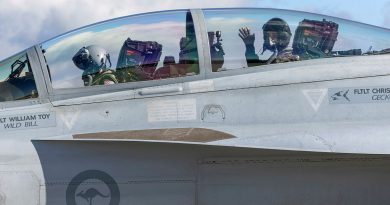2019 Federal Budget – Defence

Defence Minister Christopher Pyne and Minister for Defence Industry have released a statement on the 2019-2020 Federal Budget…
The 2019–20 Budget sees continued strong investment in Australia’s national security, with a particular focus on enhancing our regional security, building defence capability and supporting Australia’s sovereign defence industry.
FILE PHOTO (December 2017): Air Warfare Destroyer HMAS Hobart successfully fires a Harpoon Blast Test Vehicle in the East Australian Exercise Area, proving the capability of the ship to launch Harpoon missiles. Photo by Leading Seaman Peter Thompson.
The Budget maintains the government’s commitment to grow the Defence budget to two per cent of GDP by 2020–21. The government will allocate Defence $38.7 billion in 2019-20 and $175.8 billion to 2022-23 [the next four years].
REGIONAL AND GLOBAL SECURITY
As our security environment evolves, we are increasing Australia’s commitment to regional and global security to protect our interests at home and abroad.
Australia currently has around 2300 Defence personnel deployed around the world, including on operations across the Middle East Region and Afghanistan.
Australia will continue to make a meaningful contribution to the US-led international Counter-Daesh coalition in Iraq. For this reason, Australia has around 400 personnel deployed as part of Operation OKRA.
The Australian government is committed to assisting the government of Afghanistan to control its security and to make sure the nation never again becoming a safe-haven for terrorist networks. Operation HIGHROAD will continue to provide security, development assistance and capability building for Afghan institutions.
Defence will also continue to support other government agencies to keep our borders safe and maintain the capability to support Australians affected by flooding, cyclones and other natural disasters.
The Australian Defence Force contributes to the whole-of-government effort to protect our borders through Operation RESOLUTE. At any one time, up to 600 personnel at sea, in the air and on the land, are working to protect Australia’s borders and offshore maritime interests.
Defence is also playing a crucial part of the Morrison Government’s Pacific step-up. This includes:
- building Fiji’s Blackrock Peacekeeping Humanitarian Assistance and Disaster Relief Camp into a regional hub for police and peacekeeping training;
- working with the Solomon Islands and Vanuatu to increase security cooperation; and
- helping to develop the Papua New Guinea Defence Force’s Lombrum Naval Base in Manus Province and increase the inter-operability between our defence forces.
Defence will also increase the level of support to Southeast Asian countries including:
- increased frequency of visits and training opportunities for regional countries;
- supporting the training of regional military forces in Australia, including the
$2.25 billion Australia–Singapore Military Training Initiative in central and north Queensland; - continuing to work cooperatively with regional countries to support their security, including through the Five Power Defence Arrangement; and
- assisting the Armed Forces of the Philippines with counter-terrorism training to counter Daesh’s influence in the southern Philippines.
DELIVERING THE INTEGRATED INVESTMENT PROGRAM
The government is increasing investment in advanced Defence capabilities, while boosting Australia’s sovereign defence industry and creating Australian jobs.
Over the next decade to 2028-29, the government is investing more than $200 billion in Defence capabilities including:
- the continuous naval shipbuilding program, which is investing around $90 billion to build world-class vessels, while also building a strong and viable Australian naval shipbuilding industry;
- continuing the purchase of the 5th generation F-35 Joint Strike Fighter and P-8A Poseidon maritime surveillance aircraft to provide Australia with regionally superior combat and maritime surveillance capabilities;
- continuing to upgrade our EA-18G Growler electronic attack aircraft and E-7A Wedgetail battlespace management aircraft; and,
- building our policy and intelligence capabilities to ensure Australia has a deeper understanding of the world we live in.
DEFENCE CAPABILITY INVESTMENT
Since the release of the 2018-19 Budget, the government has committed around $47.5 billion to new capabilities including:
- signing the Strategic Partnering Agreement for the $50 billion Attack-class submarine program, which will see 12 regionally superior submarines designed and built in Australia;
- nine Hunter-class frigates, valued at $35 billion, to replace the Anzac-class frigates from the late 2020s. The Hunter-class will be a highly capable and lethal surface-combat capability;
- a fleet of 211 new advanced Combat Reconnaissance Vehicles to protect our troops, with the majority to be manufactured by Australian workers in Queensland, using Australian steel;
- unmanned maritime patrol aircraft, with an initial investment valued at $1.4 billion to acquire the MQ-4C Triton through a cooperative program with the United States Navy;
- Integrated Soldier Systems, valued at up to $1 billion, that will deliver a broad range of equipment to ensure ADF personnel continue to meet emerging threats and that are less detectable, less susceptible to enemy attacks and able to fight longer and more effectively in challenging conditions; and,
- the first tranche of the $1.1 billion Defence Fuel Transformation Program to deliver a safer, simpler and more assured Defence fuel network in partnership with industry.
NAVAL SHIPBUILDING PROGRAM
The government’s $90 billion investment in continuous ship and submarine building is the largest regeneration of the Navy since the Second World War. Fifty-four naval ships will be built in Australia using Australian steel. This commitment will create thousands of jobs for decades to come.
Development of the Osborne North Shipyard in South Australia is continuing in preparation for the construction of the 12 new Attack-class submarines.
The $535 million infrastructure redevelopment at Osborne South is on track to be completed in early 2020, in time for the start of Hunter-class frigate prototyping. Nine Hunter-class frigates will be built at the shipyard.
The first two Arafura-class offshore patrol vessels (OPVs) are being built in existing facilities at Osborne South. Twelve OPVs will be built as part of the $3.6 billion investment to protect our borders and replace the existing patrol boat fleet. Ten OPVs will be built at Henderson in Western Australia. This project will also help sustain critical skills in Australia’s naval shipbuilding workforce.
Plans for the upgrade and development of facilities in WA to support the Hunter-class frigates and the Arafura-class offshore patrol vessels are progressing. Around $1.5 billion dollars will be spent on infrastructure in WA to support our new fleet.
Twenty-one Guardian-class patrol boats are being built in WA to help our Pacific neighbours and Timor-Leste. Our $504 million investment will improve the security and prosperity of the region.
SUPPORTING DEFENCE INDUSTRY
The government is making additional investments in our national sovereign industrial capacity, which will ensure we can respond to changes to Australia’s future security situation. The government’s actions include:
- implementing the Defence Industry Skilling and Science, Technology, Engineering and Mathematics (STEM) Strategy, released by the government in February 2019, which outlines support to help our defence industry to meet anticipated workforce and skills demand over the next decade;
- establishing the Defence Global Competitiveness Grant program, an initiative of the Defence Export Strategy (launched in January 2018), investing up to $4.1 million a year to support small to medium enterprises to overcome barriers in accessing export opportunities;
- establishing the Sovereign Industrial Capability Grant program, a key initiative of the Defence Industrial Capability Plan (launched in November 2018) to invest up to $17 million per year in grants to build the capacity and capability of Australian small- to medium-sized enterprises to deliver operationally critical capability for Defence;
- providing advisory and facilitation services through the Centre for Defence Industry Capability for 550 small and medium enterprises, issuing over $3 million in grants and conducted stakeholder outreach events which have been delivered to more than 5000 participants; and,
- administering the Defence Innovation Hub which has received more than 800 innovation proposals and awarded around $100 million in contracts and an additional 12 Special Notice contracts worth around $10 million focused on specific capability challenges.
ENHANCING CYBER SECURITY
The government continues to invest in the Australian Signals Directorate, including the Australian Cyber Security Centre, to deliver intelligence, cyber security and offensive operations in support of the Australian government and ADF.
As part of our continued investment to protect government networks from hostile cyber compromise, and ensure the integrity of the 2019 federal election, the government is investing in the creation of cyber security ‘SPRINT teams’ and a Cyber Security Response Fund.
LOCAL JOBS SUPPORTING THE DEFENCE ESTATE
The government continues to invest in upgrading and expanding the Defence estate, comprising hundreds of bases, facilities and other sites right across Australia, particularly in regional communities.
The government has commenced pilots of Local Industry Capability Plans for major Defence infrastructure projects to ensure local industry has the best opportunity to be involved in our unprecedented investment in Defence capability. Pilot projects include:
- the HMAS Cerberus Redevelopment Project in Victoria – a $465.6 million project;
- the Explosive Ordnance Logistics Reform Program – a $230.9 million project covering 12 Defence sites across Australia;
- the Shoalwater Bay Training Area Redevelopment in Queensland – an approximately $135 million infrastructure upgrade project; and,
- a program of works worth approximately $112 million comprising the Townsville Field Training Area Mid-Term Refresh, RAAF Base Townsville Mid-Term Refresh and the HMAS Cairns Mid-Term Refresh in Queensland,
All of these investments and initiatives continue to ensure that we remain on track to implement the plans as set out in the 2016 Defence White Paper to keep Australia safe and secure, while maximising the involvement of Australian industry in our unprecedented capability investment.
.
.
.
.
.
.

.
.





